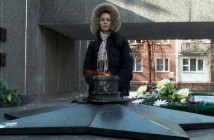
Editor’s Note: The following review is part of our coverage of TIFF’s The Crisis of the Real: New Chinese Independent Documentaries. For more information, visit tiff.net and follow TIFF on Twitter at @TIFF_NET.
Canada-trained filmmaker Gu Tao’s first full-length work chronicles in a blunt manner the effects of twenty-first century modernisation on the ethnic group of the Ewenkis. Gu is not unfamiliar with working with the Ewenkis, as his first two works also center on their community, ways of life, and livelihood. Moreover, Gu’s father was a photographer who had documented the Ewenkis and occasionally had brought Gu with him in his visits with them. For The Last Moose of Aoluguya, Gu spent eight years with the Ewenkis in the northeast, inner Mongolian region of Aoluguya, not simply as an outsider looking in but rather working with them across different seasons and getting to know how they live — or more appropriately, cope. For the film presents a gutted community as a result of government-imposed relocation and laws that effectively put an end to its life-ways, particularly moose farming, in the Greater Xing’an Mountains. Anchoring this portrait of the Ewenkis is Weijia, whose deeply forged sense of being and living he sees gradually being taken way and who gives himself over to alcohol as a coping mechanism.
The film begins with Weijia sitting on a bed and recounting his experiences while seemingly drunk, which ultimately establishes the film’s simultaneously indignant and wistful tone. More specifically, when he states, ‘We Ewenkis. […] ‘Look what resettlement did to us,’ he also plainly articulates the film’s subject. What Weijia means by ‘resettlement’ is the 2003 forced relocation of the Ewenkis from within the Greater Xing’an Mountains to outside of them and the banning of hunting and confiscation of their guns, which were essentially their means of living. For Weijia, a moose hunter, such ‘resettlement’ hits very keenly. Yet his experience is sadly not unique and not confined to the Ewenkis. The moose and reindeer that are so much a part of their community also find their numbers increasingly dwindling due to deforestation, relocation, and starvation.
Without being overly detailed in charting the impact of the resettlement as well as of other acts against the area like deforestation, the film registers it rather powerfully through its choice of following primarily Weijia experiencing changes to his living over the course of five years: beginning with the first year of the resettlement through to the third year in the new settlement (of living in government-constructed housing), then to the fourth year where Weijia finds himself in the opposite southernmost island of China, and finally back in Aoluguya in the fifth year. Throughout it all, Weijia is subject to forces and conditions beyond his control that negatively affect the way of living that he has always known. He therefore stands for the individual Ewenki as well as for the fauna with which the community thrives and survives, hence the film’s title. But how he expresses himself physically, verbally in reaction to these forces and conditions is what lends the film an indignant, resistant tone and prevents it from being a work of condescending sympathy or pity.
Weijia is foul-mouthed, uninhibited, and often inebriated, and he does not care a whit about the camera getting it all. On this note, his brash presence reminds one of the very strong, marginalised personalities that are often at the center of Japanese filmmaker Hara Kazuo’s films and for/through whom Hara is able to present a platform for their self-expression and address taboo issues. At one point, Weijia shares with the camera, ‘If I don’t drink, I can’t speak my mind.’ These words are plaintive and defiant of the condition of rootlessness that has accompanied the Ewenkis’ resettlement. This particular tone is further reinforced by a particular sequence that intersperses footage of reindeer at the camp before the move to government housing and Weijia speaking with an elder — now relocated to the housing — about younger generations ‘becoming Chinese.’ Weijia himself is eloquently frank in detailing how drinking was not an issue in pre-2003 days, while post-2003 has witnessed the passing of a number of his friends.
Weijia thus manifests on both a literal and abstract level how the Ewenkis are in some sense a condemned, disappearing community, drinking itself to death as the chosen outlet with which to convey their discontent and/or (not) live with their resettlement. Indeed, even when Weijia marries a teacher named Xia and moves to her native Sanya on Hainan Island, he carries both emotionally and physically the discontent and pain of having been uprooted. This portion of the film is perhaps the most illuminating with regards to capturing the sense of uprootedness and warding off encroaching modernisation that have now become Weijia’s life. Sanya’s tropical colours and light are a stark contrast to Weijia’s mindset. For a while, it appears that Weijia has adapted well to his new surroundings and marital status, even painting. However, when Xia urges Weijia to attend her English class, though he tries it out for a while, the sequence’s concluding shot of the classroom on the left side of the frame and Weijia on the right side lying in bed in another room on the right side of the frame imparts all too clearly a social disconnect.



